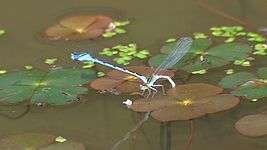Enallagma cyathigerum
| Common blue damselfly | |
|---|---|
.jpg) | |
| young adult male | |
.jpg) | |
| young adult female | |
| Scientific classification | |
| Kingdom: | Animalia |
| Phylum: | Arthropoda |
| Class: | Insecta |
| Order: | Odonata |
| Suborder: | Zygoptera |
| Family: | Coenagrionidae |
| Genus: | Enallagma |
| Species: | E. cyathigerum |
| Binomial name | |
| Enallagma cyathigerum (Charpentier, 1840) | |
Enallagma cyathigerum (common blue damselfly, common bluet, or northern bluet) is a European damselfly. The species can reach a length of 32 to 35 mm (1.3 to 1.4 in). It is common in all of Europe, except for Iceland.
Identification
The common blue damselfly can be easily mistaken for the azure damselfly (Coenagrion puella), but on the back and the thorax, the common blue damselfly has more blue than black; for the azure damselfly it is the other way around. The second segment of the thorax has a distinctive spot with a line below connecting to the third segment.
Another difference can be observed when inspecting the side of the thorax. The common blue damselfly has only one small black stripe there, while all other blue damselflies have two. A male is blue while a female is brown on a common blue damselfly.
During mating, the male clasps the female by her neck while she bends her body around to his reproductive organs – this is called a mating wheel. The pair flies together over the water and eggs are laid within a suitable plant, just below the surface.
The eggs hatch and the larvae, called nymphs, live in the water and feed on small aquatic animals. Nymphs climb out of the water up a suitable stem to moult into damselflies.
.jpg) Distinctive marking at base of abdomen of male segment S2
Distinctive marking at base of abdomen of male segment S2_male_dark_variant.jpg) adult male, dark variant of S2
adult male, dark variant of S2_newly_emerged.jpg) newly emerged
newly emerged_immature_male.jpg) immature male
immature male_male_dorsal.jpg) adult male
adult male_male.jpg) adult male
adult male_heterochrome_female.jpg) heterochrome female
heterochrome female_heterochrome_female_(green_variety).jpg) heterochrome female (green variety)
heterochrome female (green variety)
Behaviour
This small, brightly coloured damselfly is probably the most common of dragonflies and damselflies throughout much of Britain. It inhabits a wide range of habitats, from small ponds to rivers. They are especially common at lakes and reservoirs. Once the damselflies are in tandem and perched, the female can swing her abdomen to initiate pairing.
This damselfly requires a close look for a beginner to distinguish them from an azure damselfly. Typically, they fly low through the reeds and often fly well out over the water, unlike azure damselflies. They are also a brighter blue.
_(heterochrome_female)_in_tandem.jpg) in tandem
in tandem
(heterochrome female)_(homochrome_female)_in_tandem.jpg) in tandem
in tandem
(homochrome female)_mating_composite.jpg) female initiating mating
female initiating mating
(heterochrome female)_female_dull_green_form_mating_wheel.jpg) mating wheel
mating wheel
(female dull green form) oviposition on Marsilea quadrifolia
oviposition on Marsilea quadrifolia
See also
- Azure damselfly, a similar looking species
- Ischnura heterosticta, a similar Australian damselfly
- List of British dragonflies
References
- "Common Blue Damselfly". British Dragonfly Society. Retrieved 16 August 2010.
External links
 Media related to Enallagma cyathigerum at Wikimedia Commons
Media related to Enallagma cyathigerum at Wikimedia Commons Data related to Enallagma cyathigerum at Wikispecies
Data related to Enallagma cyathigerum at Wikispecies